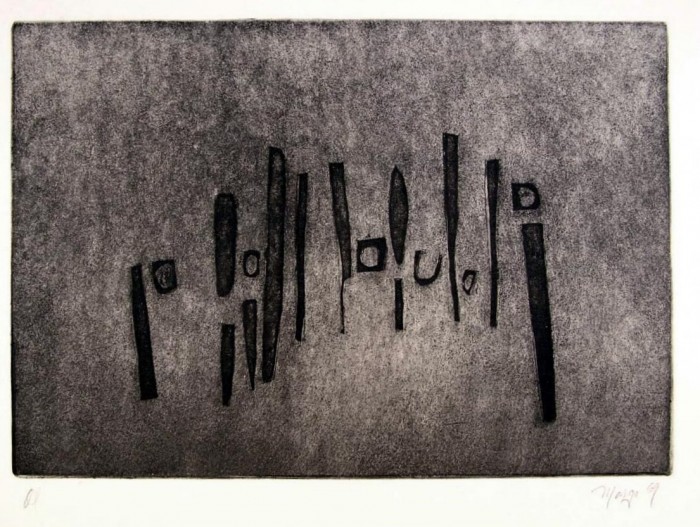Abstract Composition

Boris Margo (1902-1995), [Abstract Composition], 1969, etching, aquatint and embossing [cellocut method] signed and dated in pencil lower right margin; initialed AP lower left. In pristine condition, on BFK RIVES cream wove paper, with their watermark, the full sheet, 8 7/8 x 12 7/8, the sheet 13 x 19 3/4 inches. Archival mounting (mylar unattached hinging between acid free boards, glassine cover).
A fine atmospheric impression.
Here Margo creates a powerful image, using a rather more direct composition than in many of his works, and working with only black and white, and a range of intermediate greys.
This impression was made shortly after completion of the important catalogue raisonne of Margo’s print work (Gelb and Schmeckebier, Boris Margo Graphic Work, 1932-1968). However we believe this work was done using the cellocut method, a printmaking technique which Margo invented. Margo had been making prints of cut plywood, but one day found a piece of celluloid on the ground, and began using it as a printing matrix. It is subject to solvents, and so there were various ways in which the celluloid could be worked upon: by dripping a solvent onto it, by brushing or drawing on it with the solvent.
Best known as a painter of surrealist imagery, Boris Margo was born in Wolotschisk, Ukraine, in Russia. In 1919 he enrolled at the Polytechnik of Art at Odessa, and in 1924 received a grant to study at the Futemas (Workshop for the Art of the Future) in Moscow. A second grant enabled him to study the work of the old masters in the Hermitage Museum in Leningrad and to attend Pavel Filonov’s Analytical School of Art in 1927. In 1928 Margo received a certificate from the Polytechnik and immigrated to Montreal, where he worked as a muralist for a year. Moving to New York City in 1930, he studied at the Roerich Museum and two years later began teaching there.
Margo appeared in a show called “The Ideographic Process” at the famed Betty Parsons Gallery in 1947, along with Hans Hoffman, Rothko, Ad Reinhardt, and a year later had his own one man show with Betty Parsons. Later important shows were held at the Brooklyn Museum, the Tweed Gallery at the University of Minnesota, Duluth, and the Michael Rosenfeld Gallery in New York in 1993.